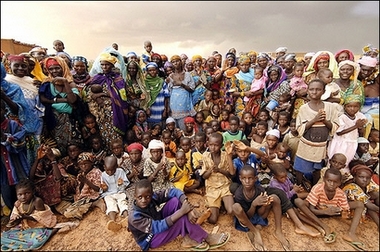| @wehaitians.com | |
No one writes to the tyrants | |
HistoryHeads/Not Just Fade Away |
| Correspond with us, including our executive editor, professor Yves A. Isidor, via electronic mail: |
| letters@wehaitians.com; by way of a telephone: 617-852-7672. |
| Want to send this page or a link to a friend? Click on mail at the top of this window. |
|
 |
|
| Posted Tuesday, April 3, 2007 |
| Despite bumper grain crop, 33 countries, including Haiti, in food crisis |
| By Agence France-Presse |
ROME, Apr. 3, 2007 (AFP) - Despite projections of a bumper grain crop this year, 33 countries will not have enough food, with Iraq and Zimbabwe among the hardest hit, the UN food agency said Tuesday.
 |
| Nigerios women and their children gather at the Medecins sans Frontiers (Doctors without Borders) center in Halfou in 2005. |
Countries with "widespread lack of access to food" include Afghanistan, North Korea, Eritrea, Ethiopia, Haiti, Liberia, Mauritania, Nepal, Niger and Sierra Leone, according to the April issue of the Food and Agriculture Organisations "Crop Prospects and Food Situation" report.
Hardest hit, with an "exceptional shortfall" in food production and supplies, are Iraq, Lesotho, the Philippines, Swaziland and Zimbabwe, the FAO said.
In eastern Africa, millions "still depend on food assistance ... due to a combination of factors including conflict and adverse weather conditions," it said.
In southern Africa, preliminary forecasts suggest a below-average maize yield similar to that of 2006, the statement said, although prospects vary from country to country.
Prospects are good overall in Latin America and the Caribbean, except for in Bolivia, where severe weather, ranging from torrential rains to drought, has caused extensive losses to agriculture, livestock and other assets.
World cereal production is forecast to increase by 4.3 percent to a record two billion tonnes, the Rome-based agency said.
"The bulk of the increase is expected in maize, (and) a significant rise in wheat output is also foreseen, with a recovery in some major exporting countries after weather problems last year," it said.
About half of the increase -- some 41 million tonnes -- will come from the production of "coarse grains," mainly maize, in North and South America to meet surging demand for ethanol fuel, the FAO study found.
Copyright © 2007 Agence France Presse
| Wehaitians.com, the scholarly journal of democracy and human rights |
| More from wehaitians.com |